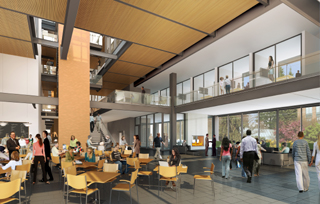
DJC.COM
August 28, 2008
UW building to get B-school students mingling
LMN Architects

Shaw
|
Modern business school education relies on fostering a rich network of relationships among and across diverse communities.
The success of the University of Washington’s Michael G. Foster School of Business will be greatly enhanced by innovative architectural design that effectively supports the complexity of its educational and entrepreneurial culture.
The Foster School is in the midst of a transformation, with the goal to become the top public business school in the nation. At the heart of this transformation is the concept of integrated communities, a concept that informs every aspect of LMN Architects’ design for Paccar Hall. Scheduled to begin construction on Sept. 26, the fundamentally modern building will embody the business school’s focus on leadership development, strategic thinking and collaboration.
“The way business is taught today involves exposing students to the concept of teams — their power, effective operation, psychology and dynamics within the corporate framework,” says James Jiambalvo, dean of the business school. “A building designed to facilitate such interaction creates a fertile environment for discovery and innovation.”
Interconnected complex

Image courtesy of Studio 216 Classrooms, a café and student commons will be organized around a central atrium to create a community activity zone. |
Situated to the north of historic Denny Hall in the heart of University of Washington’s main campus, the 135,000-square-foot, privately funded project will transform the current collection of outdated business school facilities into a cohesive, interconnected education complex that directly supports the Foster School’s goals.
Sellen Construction Co. is the general contractor for phase one. Construction of a second-phase, 60,000-square-foot building is planned to begin following Paccar Hall’s completion in July of 2010, and will replace Balmer Hall, an adjacent and run-down 1960s classroom building.
The new buildings will be linked with one another and to the existing Bank of America Executive Education Center and the Foster Business Library. The completed project will support an extensive range of educational functions, imbued with a high degree of flexibility to cultivate both the pragmatic requirements and collaborative spirit of the multilayered user communities.
A range of interactions
Diversity of program spaces and multifunctional design works on many levels. The design of Paccar Hall integrates built space, technology and the natural environment to create flexible program spaces with a multiplicity of possibilities for how they are used together.
For example, the central “gallery” space, a three-story-high, glazed atrium that will run the length of Paccar Hall, embodies a level of diverse interaction like no other on campus. Classrooms of varying sizes, small group breakout rooms, student commons, a café and covered terrace areas are organized around this central atrium to create a community activity zone.
Students, faculty, staff and visitors will have an around-the-clock presence. From the circulation between classes to small-group study sessions, special events, receptions and many other programmed functions, the gallery will be the physical armature that supports the multifaceted communities of modern business education.
Also at the core of the Paccar Hall experience will be tiered, U-shaped classrooms to cultivate interactive student-to-student discussion and small-group breakout rooms that are acoustically isolated, both of which will facilitate opportunities for nurturing the skills of teamwork and relationship-building — key qualities sought by leading companies.
Connected to campus
The design for Paccar Hall is very porous — both visually and functionally. Extensive use of glass (appropriately shielded from direct solar glare) will capture abundant daylight throughout the central atrium and common interaction spaces, creating an overall airiness that blurs the distinction between inside and outside.
The interior spaces, views and entrances are organized to knit together with the landscape, site topography and campus pathways. Both Paccar Hall and the phase-two building will have gracious plazas and a shared courtyard that the rest of the campus community can use, mixing the daily life of the school with that of the campus.
Paccar Hall’s outward architectural expression reflects a strong sense of community engagement. While its scale, proportion and use of materials are responsive to its historic campus context, the building will have a prominent physical presence at the Memorial Way campus entrance.
Together with the law school, Paccar Hall will frame the ceremonial, tree-lined drive. Its brick, glass and metal exterior combines a respect for the character of the campus with the forward-looking nature of business education.
Rooted, but reaching out
Part of the Foster School’s strategy to become the nation’s top public business school involves leveraging Seattle’s assets — its location on the Pacific Rim and its connection to so many leading-edge companies.
The new state-of-the-art facilities will bolster the school’s competitiveness, attracting the best and brightest students, the leading minds for faculty, and the top companies as partners for internships and action-learning opportunities.
For example, over the course of one quarter, 400 to 500 speakers from the region and around the globe visit the business school. With its new variety of spaces, from 25-seat classrooms to a 250-seat auditorium, the Foster School will be able to tailor the environment for the speaker and the audience.
While the entire business school complex becomes woven together to create its own clear identity and sense of place, it also reaches out to the global academic and business communities through carefully conceived integration of technology. Throughout both buildings, enhanced technological capabilities such as Web-linked digital monitors and distance conferencing capabilities will support the intensive, continuous nature of communication in today’s global business world.
Business ‘convergence zone’
Preparing students for the corporate environment of today and into the future will necessitate a sophisticated knowledge of team-based strategic operations, teamwork and relationship-building beyond the walls of the boardroom and into an increasingly complex global arena. Paccar Hall is a powerful example of how the core dynamic of modern business education can become embedded in the design of the building.
“Paccar Hall will quite literally be where ‘business’ meets ‘school’ in the Pacific Northwest,” says Jiambalvo. “When the doors open in 2010, we envision a place that will act as a convergence zone for the business community — a place that will bring together business leaders, faculty and students and allow us to optimize the educational experience.”
George Shaw is a partner at LMN Architects, where he leads many of the firm’s complex, large-scale public assembly, higher education, science and technology projects.
Other Stories:
- Can good design boost the case for school consolidation?
- Spend more now to save big in the long run
- Nature’s obstacles force fresh thinking in Everett
- Green goals guide UW’s Architecture Hall renovation
- What the future holds for school design
- Colleges expand to meet health care demand
- Northwest University answers call for nurses
- A science building that goes easy on energy
- The next generation of American schools
- 7 questions project managers should ask about BIM
- Tribal schools expand role preserving native cultures
- Mount Rainier inspires Orting Middle School design
Copyright ©2009 Seattle Daily Journal and DJC.COM.
Comments? Questions? Contact us.